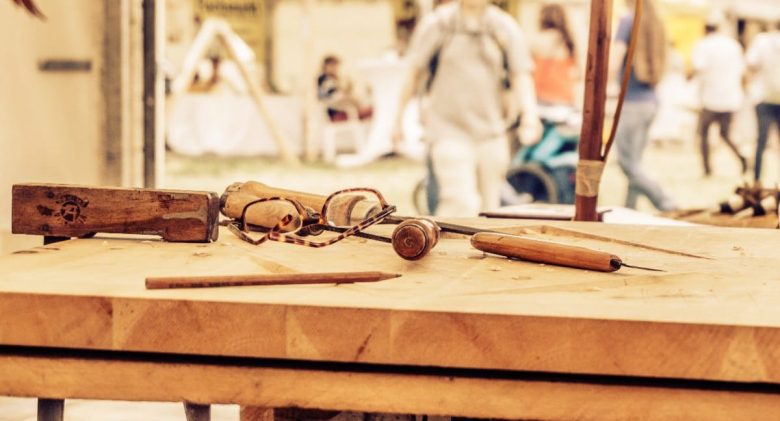From novice to expert, everyone needs a solid surface from which to work. Pre-built benches can cost a fortune, something that most of us do not have. Is building a bench really an optimal solution, and are DIY woodworking workbench plans worth looking into?
The 10 free plans below are worth looking at, and building one that fits your needs is a great way to save you money and get you working in your shop.
DIY Pete’s Simple Workbench
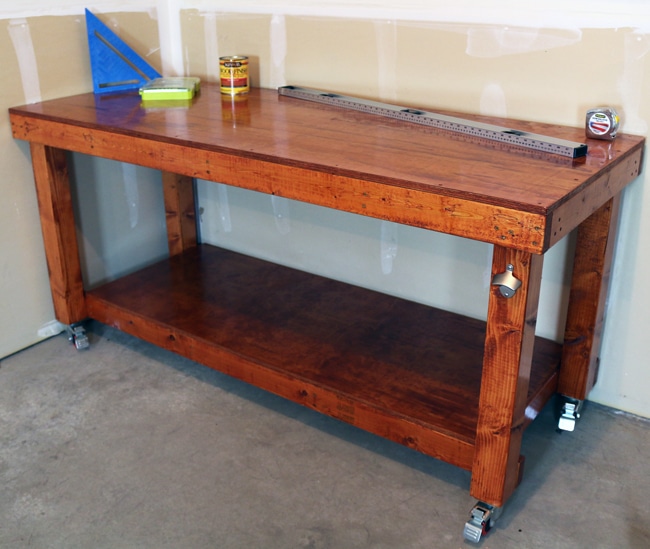
This workbench project has a rather straightforward design. You will not find any tricky joints, as everything appears to be butt joints. Screws will be used as fasteners, with wood glue helping to provide extra hold should you decide to use it.
Materials
The lumber used for the project consists of standard framing sizes of 2 x 4 and 4 x 4. Two plywood sheets (4 x 8) are also needed. I would suggest 1/2-inch thick sheets, at minimum, to provide a reasonably secure surface.
Four-inch caster wheels are included in this design to help provide mobility in the should. You will also need your favorite color of stain, along with a polyurethane coat for protection.
Who is this workbench for?
Once you add the stain and seal it with the poly, this workbench goes beyond a simple bench to cut, chisel, or clamp wood stock. I would recommend this as a secondary work surface and use both the benchtop and the shelf below it for storage. It could also serve as a bench for power tools that can be wheeled in and out of your work area.
Super Simple $50 Woodworking Bench from Family Handyman
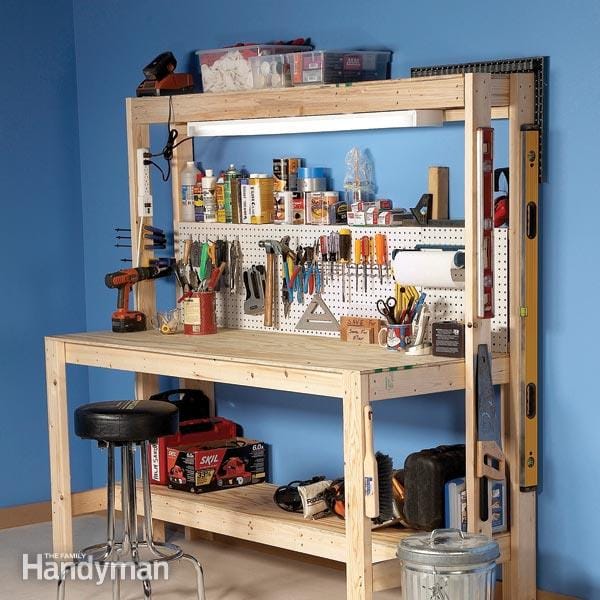
Stepping up storage and functionality from the previous entry, this economical woodworking table offers multiple layers of storage and tool holding options. Simple butt joints can be firmly held in place with wood screws and glue, and the pegboard can be held in place with just a few screws along the back.
Materials
Standard 2 x 4 framing lumbers will be used to build up the project’s frame. You can use 4 x 8 sheets of plywood sheeting that is 1/2 inch thick for the tabletop as well as the shelves. Finally, pegboard sheets are added to this workbench to provide a vertical tool storage surface.
Who is this workbench for?
The vertical storage on the pegboard makes this an ideal design for woodworkers who like hand tools. Placing hooks or pegs into the holes on this surface will support marking tools, measuring tools, and small one-handed tools. Larger and heavier hand tools, such as hand planes, can be stored on the shelf space this work table provides. You will be able to store most of your basic woodworking tools and accessories in this workbench.
Most jobs can be done on the table surface in this design, except for working on wide panels. Unfortunately, the pegboard and upper storage prevent large panels from hanging off of the backside of the tabletop.
A Workbench from FineWoodworking That You Can Build This Weekend
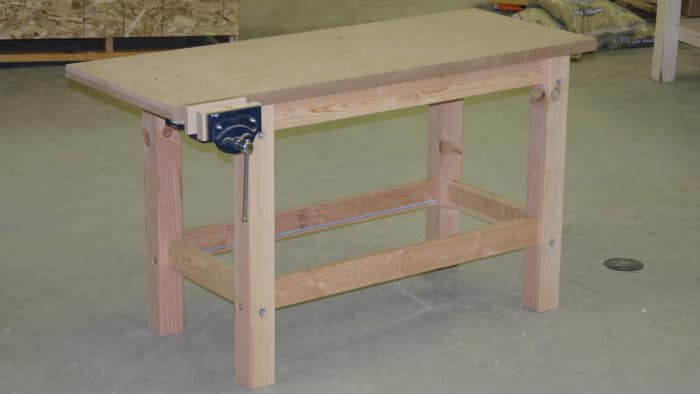
This rugged design has few frills. A small woodworking vice is the only addition to this thick-framed workbench. An MDF table surface is added to provide a flat surface that will not warp with humidity changes.
Wood screws and wood glue will help to keep everything together, and a drill and saw should be the only major tools needed to dimension and prep the lumber.
Materials
The 2 x 4 will make up the majority of the lumber that you use on this project. The only addition that I can see will be the MDF sheet used for the workbench surface. The vice hardware is an extra expense you will want to add to your budget on this project.
Who is this workbench for?
Beginners and intermediate woodworkers will appreciate the solid design that allows you access from all sides of the table. An MDF work surface will help to keep the wood that you are working on a level, even as the changes. Adding a small woodworking vice to one corner allows you to clamp projects down securely and frees up your hands for other things.
Mobile Flip Top Workbench From Saws On Skates
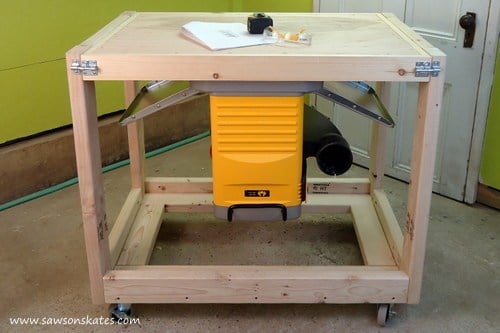
This becomes a bit more difficult to build than the previous workbench designs as the tabletop moves. If you decide to build it, you will need some extra fasteners beyond the screws and glue used on previous DIY work table plans.
If you are new to woodworking, do not become intimidated by the flip-top component. You will just need to take your time and double-check your measurements (as my grandfather used to say, “Measure twice, cut once.”).
Materials
This project changes things up a bit. While 2 x 4 framing timber is still used, they also add 1 x 2 as well as 1 x 3 timber. The designer calls for 2 x 4 plywood sheets, but you may find a bit of savings if you have a 4 x 8 sheet cut down to the smaller size.
This mobile bench will require casters and the washers needed for them. The parts list also adds a variety of screws and bolts to the mix on this build.
Who is this workbench for?
This design is ideal for a hybrid workshop. This project will allow you to mount a miter saw, portable table saw, or a good benchtop planer. The other side can be kept bare, or you can also contemplate adding another power tool if you wish.
As this design is also not as wide as some of the six-foot benches we looked at previously, it makes for a good addition to a small basement or garage work area.
Mobile Workbench With Built-in Table & Miter Saws by Beerdidtrev
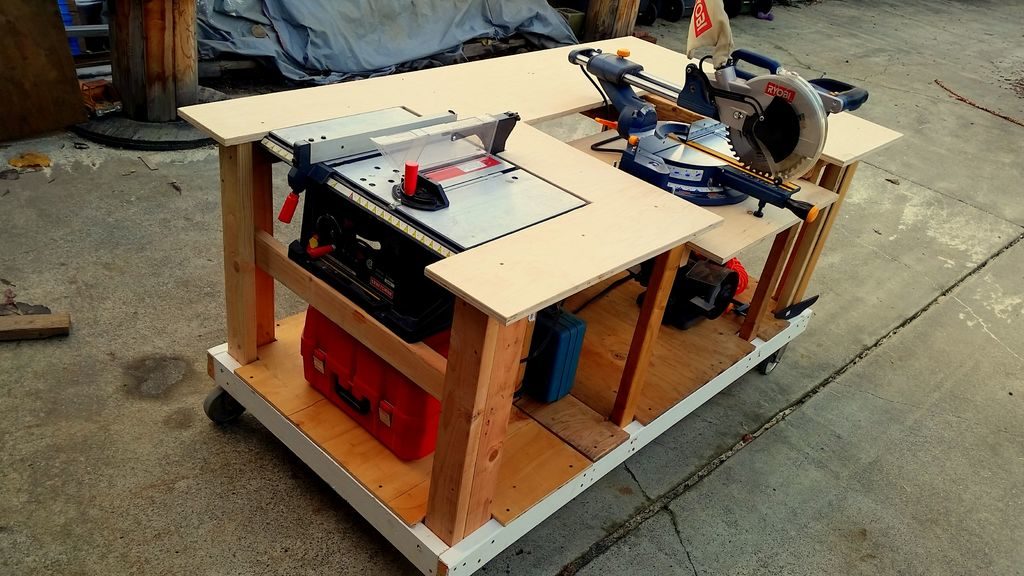
Those who are new to woodworking will get limited use from this design, but intermediate woodworkers who enjoy their power tools will be able to build and use this woodworking bench.
This design also requires the running of standard household electrical wire as well as the installation of three electrical outlets for the power tools to plug into. That includes the plug-in for the extension cord.
Materials
2 x 3 and 2 x 4 will make up the majority of the frame, with 11/16-inch plywood used for the surfaces that the power tools will sit upon. Three-inch carriage and lag bolts are required, and this design might introduce you to the T-star screw, which is used to secure the frame.
This DIY workbench plan uses maple plywood for the tabletop surfaces, but it should be noted that a thinner and less expensive plywood can be used for the storage shelves located below.
Who is this workbench for?
Intermediate and advanced woodworkers who use power tools are the subjects that this system was made for. Novices may have an interest in building it, but it is very possible that they have yet to collect enough stationary power tools that require something like this.
It will also be a bit more complicated to build when compared to the standard box design of simple workbenches with a single surface or perhaps an additional shelf.
2×4 Workbench by The WoodFather
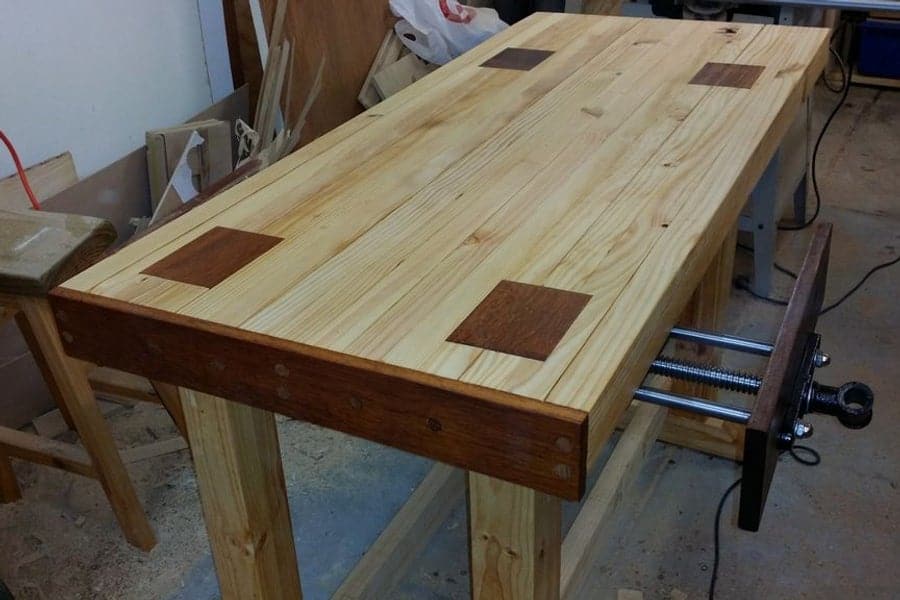
One thing to note right away is that you will be making mortise and tenons for the legs and tabletop on this project. If you follow the author’s work in his videos, you will notice that he struggled with making clean mortise and tenons. To hide the mess, he added hardwood inserts that are darker in color.
I bring this up as this step will not be necessary if you take your time when cutting them out. This might not be the best project to cut your first mortise and tenons on. It is worth noting that bolts and wood glue are used to hold parts in place once they are assembled.
Materials
You will need a lot of 2 x 4 timber, not only for the frame but also for the tabletop itself. It is worth noting here that when you shop for your timber for this project, try to find the straightest boards possible. That includes looking for planks that have little to no twist in them.
I suggest stocking up on wood glue before starting this project, as well. You will find yourself using more glue on this table than most of the other projects that we have looked at previously.
Who is this workbench for?
This style of bench can be useful to anyone, and beginners can take on the challenge of mortises and tenons successfully if they take their time and work down to the cut lines without going over them. A heavy top workbench like this is ideal for any shop.
DIY Portable Workbench with Storage from Rogue Engineer
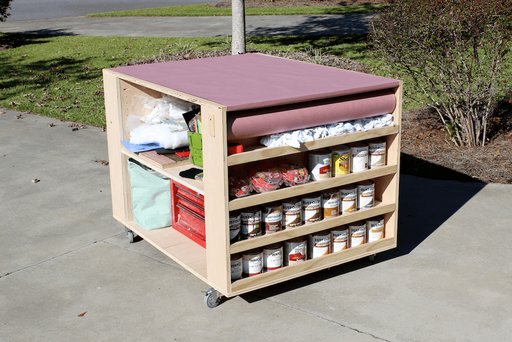
Two things will stand out to you as you look at these DIY workbench plans. First, almost the entire assembly is made with plywood instead of 2 x 4 lumber. Secondly, this workbench is designed for staining (see below).
The designer suggests using 3/4-inch plywood, and I agree with that. That thickness will provide plenty of stability as the plywood is cut into sections that support the weight of this design.
Materials
Three sheets of 3/4 inch plywood measuring 4 x 8 feet will be needed. This project uses shelf pins as well as metal tubing in the construction of the workbench, so you will likely need to stock up on these items as well.
A roll of rosin paper is incorporated in this table’s design and you will have to source this separately as well. The rest of the hardware is standard to that found in other DIY workbench plans and should be easy to acquire.
Who is this workbench for?
This workbench could actually be called a staining station. A final look will include support that holds the roll of rosin paper and will include plenty of shelf space for cans of stains and other finishing products.
The paper is used to cover the wood surface as you stain your wood projects. Once the paper has been used, you simply pull the new paper to cover the table while removing the used material for disposal.
Easy Build Workbench by Ursula Carmona
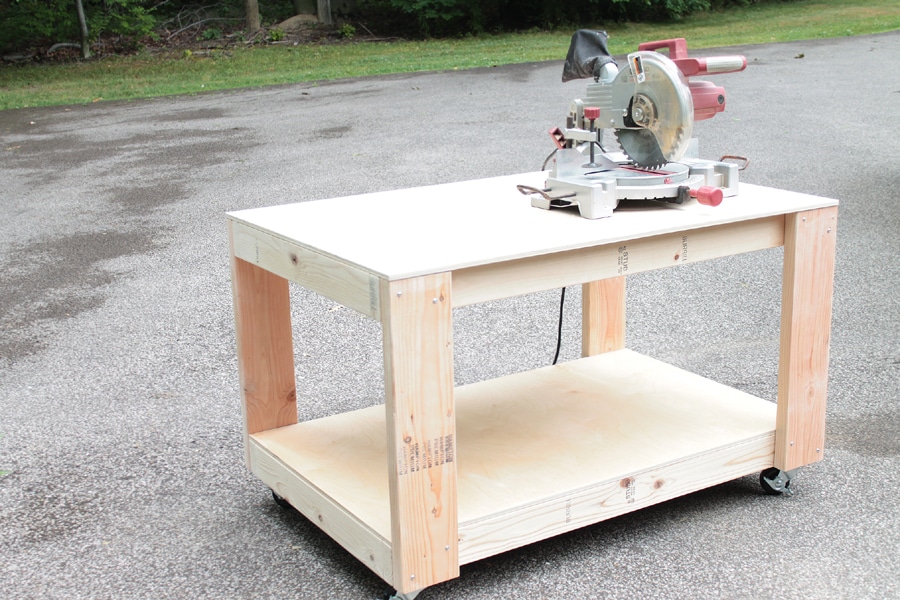
Here is a standard workbench design that will be much lighter in weight than the previous 2 x 4 workbench with a heavy tabletop. Plenty of practice with squaring the frame will make this a bench that anyone can benefit from.
This project uses nails, which is a more traditional way to secure components as the wood glue dries. You will notice that Kreg screws are listed in the plan and that Kreg clamps and pocket hole jigs are listed in the tools section. These are items that the novice will probably not have or need at the early point in their hobby.
Materials
A sheet of Birch plywood is suggested here. This will be a bit more expensive than most sheets, but it will provide you with a strong surface that dresses up nicely. That extra durability allows this table to offer good surface support when compared to other table surfaces with similar thicknesses.
A couple of 2 x 6 boards are added to the familiar 2 x 4 on this build’s material list. That wider lumber will be used in the leg portions of the workbench.
Who is this workbench for?
While anyone can build this bench, the Birch plywood is a bit pricey to use for a novice woodworker’s first bench. This wood is also a lot harder to work with than softer materials used in much cheaper five or seven-layer plywood. Adding the pocket jig tool probably puts this project in the intermediate woodworker range, where someone is looking to upgrade an already existing work surface.
Real Woodworkers Workbench by Jdege
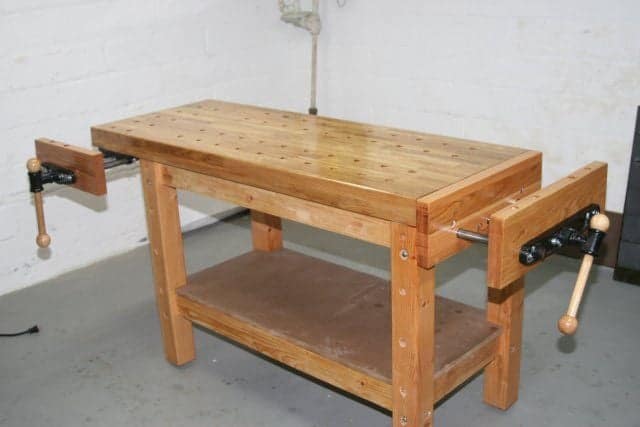
A traditional workbench look, but adding an MDF top, will provide you with a work surface that stays straight and true no matter what time of year it is. There is a lot of new hardware to look at for this build. That includes metal rods, S-clips, and levers.
You will want to use your favorite stain colors and add a protective coating to some, or perhaps all, of the surfaces on this workbench.
Materials
The stand-out material used in this project is the oak-covered MDF boards. This will give your bench a traditional look. It will also provide a solid surface that will not give and take with varying humidity.
Oak hardwood can be used wherever you would like, but it will be a necessity for the vices if you install them. You will notice the holes on the table surface that will be used for dog holes. Various dowels and pre-made components can be sourced for these holes, including bench dogs and various clamps.
Who is this workbench for?
This project is perfect for intermediate and advanced woodworkers. Especially those that work with hand tools. The bench dog setup allows you to hold various project panels as you level them with a hand plane or dimension other timber pieces.
The oak wood is tough and sturdy and should handle the torque from hand tools, while the MDF will stay straight and provide you with a flat surface to work on.
Folding Workbench with Storage from Just Measuring Up
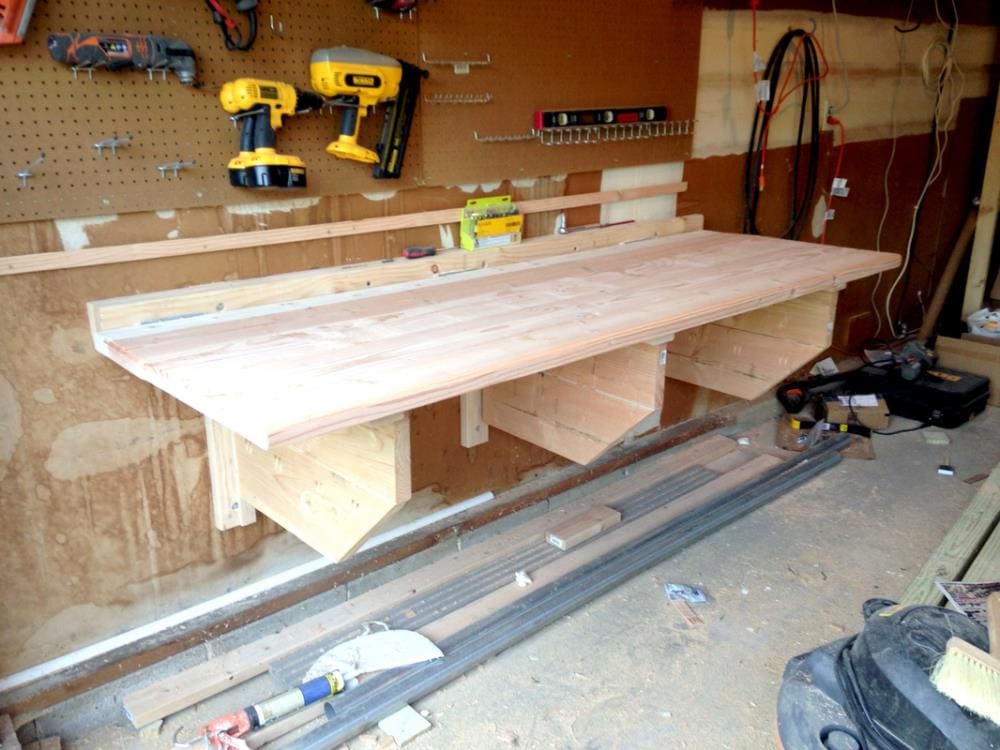
This might be called a work wall, as that would better describe this compact setup. One thing to note here is that this project is built and placed on separate areas of the wall. Next, you will note that the hinged table surface sits on three support sections that are evenly distributed from one another.
I wanted to note here that some of the hardware choices for mounting components to the wall may vary, depending on what they are connecting with.
Materials
Thinner 1 x 1.5-inch stock can be used to provide a gap between the wall and the pegboard. 2 x 4 and 2 x 8 timber will be used for the table, and you might be able to use scraps of wood for your boxes if you have enough sitting in your shop. If not, you can dimension down an extra 2 x 4 pieces.
You will be using a lot of hinges on this design, so make sure you have the right amount in stock before you begin assembly.
Who is this workbench for?
This DIY workbench plan is for anyone who has limited room. Let’s face it: no matter what your skill level is, you need a nice surface from which to work. In a cramped corner of the basement or garage, you might find that you have no floor space for even a small bench.
This wall-mounted system not only provides you with a work surface. It will also help to hold and organize tools and small objects you want to store.
Do It Yourself!
If there is one thing I have learned over the last few years as I progress with woodworking, it is that making things with your own hands is reward enough. Once you find a DIY workbench plan to start with, don’t hesitate to adjust it to fit your and your shop’s needs. Finally, no matter what, be safe and have fun.

